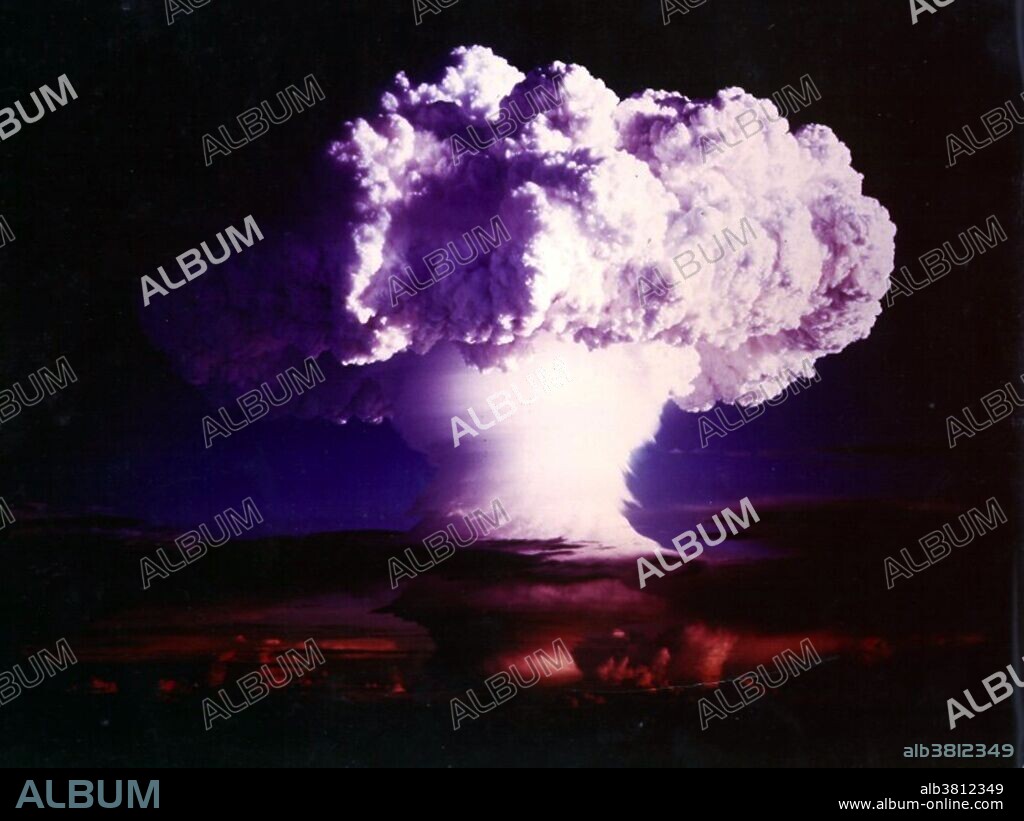alb3812349
Operation Ivy MIKE, 1952

|
Add to another lightbox |
|
Add to another lightbox |



Buy this image.
Select the use:

Title:
Operation Ivy MIKE, 1952
Caption:
Operation Ivy was the eighth series of American nuclear tests. Its purpose was to help upgrade the U.S. arsenal of nuclear weapons in response to the Soviet nuclear weapons program. The two explosions were staged in late 1952 at Eniwetok Atoll in the Pacific Proving Ground in the Marshall Islands. The first Ivy shot, Mike, was the first successful full-scale test of a multi-megaton thermonuclear weapon (hydrogen bomb) using the Teller-Ulam design. Unlike later thermonuclear weapons, Mike used deuterium as its fusion fuel, maintained as a liquid by an expensive and cumbersome cryogenic system. It was detonated on Elugelab Island on October 31, 1952, yielding 10.4 megatons, almost 500 times the yield of the bomb dropped on Nagasaki. Eight megatons of the yield was from fast fission of the uranium tamper, creating massive amounts of radioactive fallout. The detonation left an underwater crater 6,240 feet wide and 164 feet deep where Elugelab Island had been.
Category:
RESEARCH • History: United States
Credit:
Album / DOE/Science Source
Releases:
Image size:
4200 x 3150 px | 37.9 MB
Print size:
35.6 x 26.7 cm | 14.0 x 10.5 in (300 dpi)
Keywords:
1952 • 20 20TH XX XXTH TWENTIETH CENTURY • 20 XX TWENTIETH CENTURY • 20TH CENTURY • 20TH • A-BOMB • AMERICA • AMERICAN • ARMES • ARMS • ATOM BOMB • ATOMIC BOMB RESEARCH • ATOMIC BOMB TEST • ATOMIC BOMB • ATOMIC DEVICE • ATOMIC RESEARCH • ATOMIC TESTING • ATOMIC WEAPON • BLAST • BLASTING • CELEBRITIES • CELEBRITY • DETONATE • DETONATING • DETONATION • ENEWETAK ATOLL • ENIEWETOK ATOLL • ENIWETOK ATOLL • EVENT • EVENTS • EXPLODING • EXPLOSION • FAMOUS PEOPLE • FAMOUS • GUERRA • HALLOWEEN • HISTORIC • HISTORICAL • HISTORY • HISTORY: UNITED STATES • HUNDRED YEARS WAR • HYDROGEN BOMB RESEARCH • HYDROGEN BOMB TEST • HYDROGEN BOMB • HYDROGEN DEVICES HYDROGEN WEAPON • IMPORTANT • IVY MIKE • MARSHALL ISLANDS • MUSHROOM CLOUD • NOTABLE • NUCLEAR BOMB RESEARCH • NUCLEAR BOMB TEST • NUCLEAR BOMB • NUCLEAR DEVICE • NUCLEAR TESTING • NUCLEAR WEAPON • OCEAN, PACIFIC • OCTOBER 31 • OCTOBER 31ST • OPERATION IVY MIKE • OPERATION IVY • PACIFIC OCEAN • PACIFIC PROVING GROUND • PACIFIC PROVING GROUNDS • RESEARCH & DEVELOPMENT • RESEARCH AND DEVELOPMENT • RESEARCH • SCIENCE • SIEGE • SITE • TECHNOLOGICAL • TECHNOLOGY • TELLER-ULAM DESIGN • THERMONUCLEAR BOMB RESEARCH • THERMONUCLEAR BOMB TEST • THERMONUCLEAR TESTING • TWENTIETH CENTURY • UNDERWATER-DEPLOYED • UNITED STATES • US • USA • WAR • WARFARE • WARS • WEAPON OF MASS DESTRUCTION • WEAPON • WEAPONARY • WEAPONRY • WEAPONS • WELL-KNOWN • WMD
 Pinterest
Pinterest Twitter
Twitter Facebook
Facebook Copy link
Copy link Email
Email
